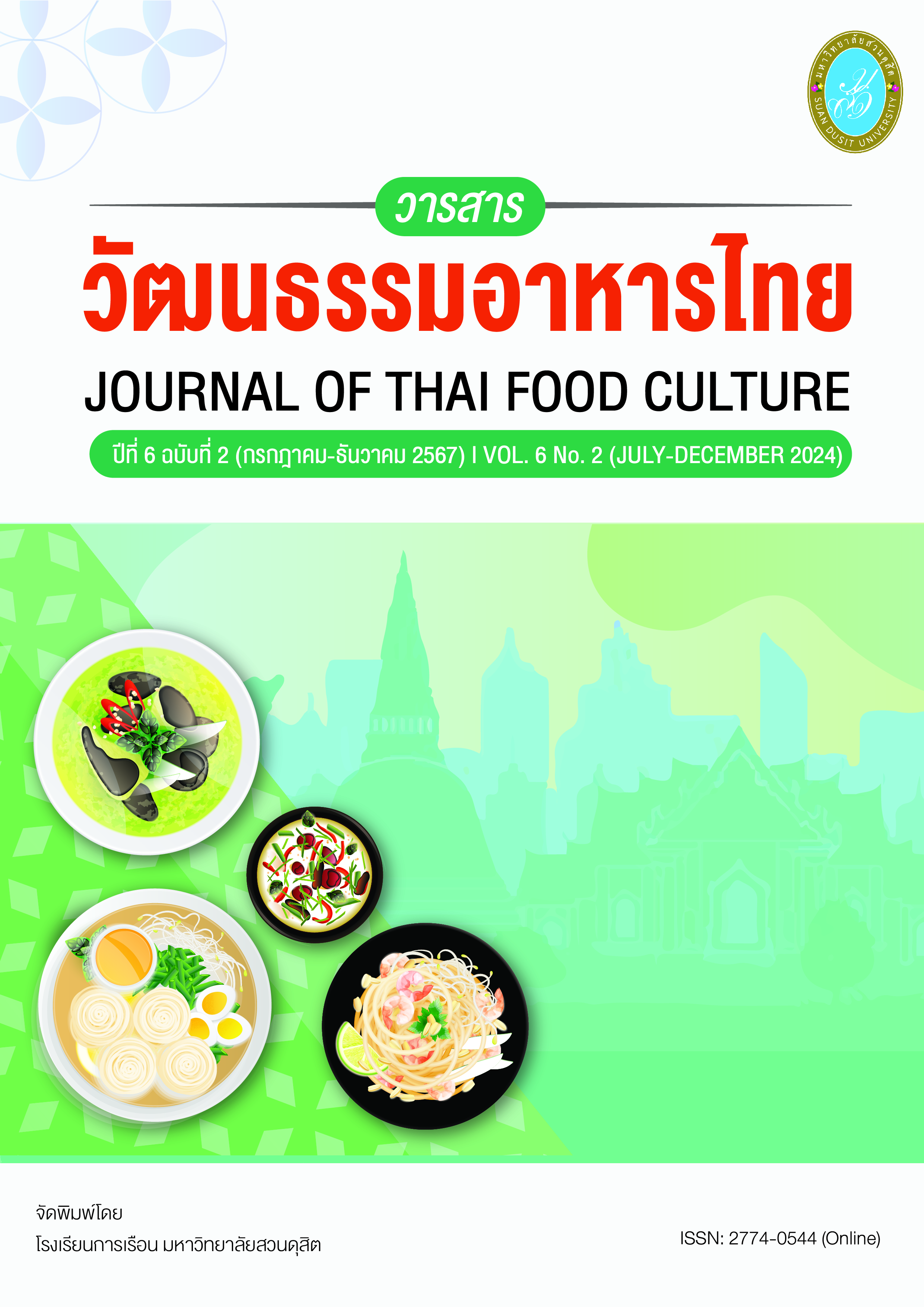Development of Cheese Pie fortified with Candied Pomelo
Keywords:
ชีสพาย เปลือกส้มโอเชื่อม การพัฒนาผลิตภัณฑ์Abstract
The purpose of this research was to study the processing of candied pomelo peel. To study the acceptance of the use of candied pomelo peels in cheese pie products and to study the use of candied grapefruit peel in cheese pie. The sample group was personnel and students. Suan Dusit University, 30 people were analyzed by mean statistics (Mean) and standard deviation (SD). The questionnaire was used to analyze the data by computer. by using a packaged program. From the study of the process of making grapefruit peel. From the selection of raw materials Sam Phran, Nakhon Pathom Province, Use pomelos with large fruits and thick peels. Then cut the pomelo peel, both the outer and inner peel, to a size of width x length 1 centimeter. Then it was put through the process of soaking, boiling, simmering and baking at 65 °C for 10 hours. completely dry welding There will be a thin sugar coating on the grapefruit peel giving it a more pronounced green and white color. Therefore, it becomes a canned pomelo peel product and can be added to cheese pie products. And from the study of the standard recipe, it was found that the tasters rated the liking of the second recipe in terms of appearance, texture, smell, taste and overall liking. The mean scores were 7.40±1.95, 8.40±0.55, 8.80±0.45, 8.20±0.84 and 8.40±0.55 respectively. Therefore, the second recipe was selected as the standard recipe. And when the grapefruit peel was added in the cheese pie products at different amounts at 3 levels, 10, 15 and 20 percent of the total cheese pie weight, it was found that consumers liked the 20 percent of the added amount in terms of appearance, color. Smell, taste, texture and overall liking were scored 7.57±1.00, 7.67±1.12, 7.37±1.40, 7.33±1.54, 7.47±1.53 and 7.63±1.10 respectively, since all aspects had an average of 7.30 – 8.19. Satisfied at the level of liking.
References
ชัยวุฒิและภาวดี. (ม.ป.ป.). เพคตินจากเปลือกส้มโอ สารก่อเจลและสารทดแทนไขมัน สำหรับอาหารเพื่อสุขภาพ. ศูนย์เทคโนโลยีโลหะและวัสดุแห่งชาติ สำนักงานพัฒนาวิทยาศาสตร์และเทคโนโลยีแห่งชาติ. สืบค้นเมื่อ 3 พฤษภาคม 2566 จาก https://www.thailandtechshow.com /view_techno.php?id=859.
ซูฟียา เจาะอารง. 2559. การเชื่อมโยงสีกับสภาวอารมณ์ของวัยรุ่นตอนปลายและผู้ใหญ่ตอนต้น. สืบค้นเมื่อ 17 เมษายม 2566 จาก https://www.psy.chula.ac.th/th/feature-articles/psychological-aspects-of-color.
ณัฐญา อัมรินทร์ และสุทธิ อัมรินทร์. (2564). ผลิตภัณฑ์น้ำมันหอมระเหยจากเปลือกส้ม. วารสาร การอาชีวศึกษาภาคกลาง. สืบค้นเมื่อ 3 พฤศจิกายน 2566 จาก https://shorturl.asia/dopBO.
นพา ลีละศุภพงษ์. (2556). การพัฒนาผลิตภัณฑ์ช็อคบอลดอกโสน. คณะวิทยาศาสตร์และเทคโนโลยี มหาวิทยาลัยราชภัฏพระนครศรีอยุธยา.
สุดาวรรณ มีเจริญ. (2552). เอกสารวิชาการ ส้มโอ. ศูนย์วิจัยพืชสวนพิจิตร สำนักวิจัยและพัฒนาการเกษตรเขตที่ 2. สืบค้นเมื่อ 19 กุมภาพันธ์ 2566 จาก http://lib.doa.go.th/multim/e-book/EB00577.pdf.
อภิรักษ์ เพียรมงคล. (2549). รายงานการวิจัยฉบับสมบูรณ์เรื่องการศึกษาความเป็นไปได้ในการผลิตเส้นใยอาหารผงจากกากส้มเขียวหวาน กากส้มสายน้ำผึ้ง กากส้มสีทอง และเปลือกในส้มโอ. ภาควิชาวิทยาศาสตร์และเทคโนโลยีการอาหาร, คณะอุตสาหกรรมเกษตร มหาวิทยาลัยเชียงใหม่.
อาภัสรา แสงนาค. (2560). เส้นใยอาหาร. กรุงเทพฯ: เท็กซ์ แอนด์เจอร์นัล พับลิเคชั่น.
Downloads
Published
How to Cite
Issue
Section
License
Copyright (c) 2025 School of Culinary Arts, Suan Dusit University

This work is licensed under a Creative Commons Attribution-NonCommercial-NoDerivatives 4.0 International License.
ลิขสิทธิ์ต้นฉบับที่ได้รับการตีพิมพ์ในวารสารวัฒนธรรมอาหารไทย ถือเป็นกรรมสิทธิ์ของโรงเรียนการเรือน มหาวิทยาลัยสวนดุสิต ห้ามผู้ใดนำข้อความทั้งหมดหรือบางส่วนไปพิมพ์ซ้ำ เว้นแต่จะได้รับอนุญาตอย่างเป็นลายลักษณ์อักษรจากโรงเรียนการเรือน มหาวิทยาลัยสวนดุสิต นอกจากนี้ เนื้อหาที่ปรากฎในบทความเป็นความรับผิดชอบของผู้เขียน ทั้งนี้ไม่รวมความผิดพลาดอันเกิดจากเทคนิคการพิมพ์


